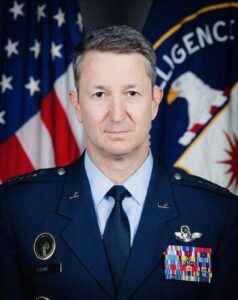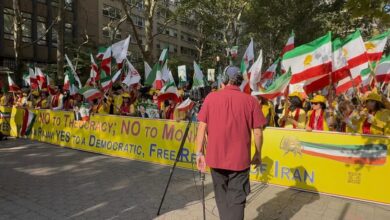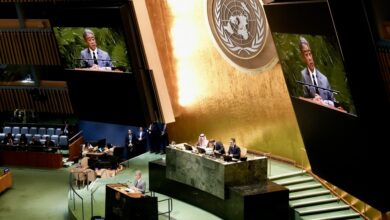On this 9/11 National Day of Service and Remembrance, #CIA’s Associate Director of Military Affairs, Lieutenant General Dan Caine, reflects on poignant days in U.S. history and American #courage through adversity.

New York – Rashad Alkhader – homeland news- From- News – CIA
September 11, 2023
“Where were you on September 11th?” A familiar question for any American old enough to remember that fateful day.
On September 11, 2001, Dan Caine was attached to the 121st Fighter Squadron at Andrews Air Force Base, serving as the Chief of Weapons and Tactics. Shortly after a second hijacked airliner hit the second tower of the World Trade Center, Caine and his colleagues received orders to protect the skies above Washington. In an unprecedented move, the U.S. military authorized individual fighter pilots based near D.C. to make the decision on whether or not to shoot down any planes that threatened the nation’s capital.
Lieutenant General Caine now serves as CIA’s Associate Director for Military Affairs (ADMA), the CIA Director’s principal advisor on military matters and the primary interlocutor between CIA and the Department of Defense. Twenty-two years ago, Caine was the mission commander over D.C., and here he shares his particularly unique and vivid memories of 9/11. That experience reinforced what he believes to be a fundamental leadership quality: the ability to keep your cool during a crisis—or “stay frosty” as they say in ADMA’s office.

* * * * * * *
York City, and you could see the impact crater of the first airplane that had hit the tower. I can clearly remember the news helicopter’s live video footage as it stared at the North tower. And then, out of the right side of the shot, we saw the second airplane enter and hit the South tower.

I certainly knew, as did my teammates, that we were a nation at war.
I picked up the telephone and called the Washington Field Office of the U.S. Secret Service. We had a close relationship with them. I asked, “Hey, what do we need to know? What’s going on?” And he replied, “I don’t know. I’ll call you back.”
I hung up and called over to our weapons storage area. Nobody there knew about what just transpired in New York. I talked to the senior enlisted leader, and I remember telling him, “Hey man, you need to unpack the live missiles and bring them over. We’re under attack.” Obviously, he was a bit shocked, questioning, “What are you talking about?”
Shortly thereafter, the phone rang. It was the White House. At the other end of the line, we could hear the Vice President of the United States telling us to get everything we could airborne and to scramble because “America’s under attack.”
We grabbed the nearest wingman, myself, and one other flight lead, and four of us ran to a briefing room where we came up with a really quick plan on how we were going to defend Washington, D.C. from further attacks. By that time, my wing commander, Brigadier General Dave Wherley, had come in holding a piece of paper. It was a faxed copy of the Rules of Engagement.
In this video clip, ADMA Lieutenant General Caine talks about the great responsibility placed on young D.C. fighter pilots in the wake of 9/11, as well as the words from his commanding officer that day:
Now, in the distance over the tree lines, you could see the acrid black smoke of the Pentagon burning.
We jumped in the airplanes and started them up. As my plane came to life, the generators came on-line, and the radios were going ballistic. People on the emergency channels were saying, “Anybody around Washington, D.C. will be shot down.” I remembered thinking to myself, “Wait. That’s me that will be shooting.”
The weapons were loaded on my airplane so we’d have the 20-millimeter gun and two heat-seeking missiles. I was airborne for about 7.5-8 hours that day.

We intercepted about a dozen different aircraft that day, signaling the pilots to change course to clear the skies around D.C.
To have the decision to shoot down an airliner resting solely on a bunch of young folks in a combat air patrol – that had never happened before. I remember telling the wingman that I was going to fly with that day, “Don’t shoot anybody. I’ll make the decision,” because I was very mindful that if we made a mistake or if we got it wrong or if we missed somebody and we did not shoot, the consequences of that could be catastrophic, not only for the people on the ground, but for the country as a whole.

Not a day goes by that I don’t at some point in the day find a reason to think about the passengers of Flight 93. When you talk about courage and you talk about America fighting back more than 20 years ago, that image and example of American courage sticks with me. They knew what was going on, and yet they still had the fortitude to go forward in that airplane, knowing three other airplanes had been hijacked.
Courage in times of adversity. That is what our country is all about. The firefighters running up those buildings knowing what was going on. The police officers doing the same. The first responders here in Washington and, for that matter, the CIA officers who stayed at their posts in the middle of all of that.
In this video clip, ADMA Lieutenant General Caine reflects on poignant days in U.S. history—including the attack on Pearl Harbor and attacks of 9/11—and shares advice for young men and women who serve the nation
:



